Alta, Utah Historical Timeline
* Compiled by William DeLeo. Source material: Alta Ski Area, Alta Historical Society and individual research.** Photos courtesy of Alta Ski Area, The Alan Engen Collection, Utah Ski Archives, and the Utah State Historical Society.
(click thumbnails to view larger images)
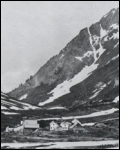 July, 1864 - Silver is discovered in upper Little Cottonwood Canyon in the area of Emma Hill. Reports vary on who found the silver ore. Some historians claim Capt. Patrick Connor of the Third Infantry of California found it while others credit an Army Surgeons wife. Still another theory suggests a logger named Ogilvie found an interesting piece of rock and brought it to Connor to have it assayed.
July, 1864 - Silver is discovered in upper Little Cottonwood Canyon in the area of Emma Hill. Reports vary on who found the silver ore. Some historians claim Capt. Patrick Connor of the Third Infantry of California found it while others credit an Army Surgeons wife. Still another theory suggests a logger named Ogilvie found an interesting piece of rock and brought it to Connor to have it assayed.
August, 1865 - First verified claim staked on the Silas Braine Fissure, later the Columbus Mine, directly across from the present day Peruvian Lodge.
1868 - The first building in Alta, a steam powered sawmill and attached boarding house, is built by Bishop Samuel A. Woolley and Nathan Davis of Salt Lake City.
1870 - Central City (also called Galena) emerges on a flat area 1 mile downstream of the present day Alta Lodge. Population grows to 216.
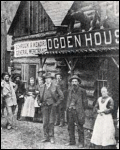 1871 - The town of Alta is established near the present day Albion chairlift. The town site consists of ten east/west and eleven north/south streets. A Post Office is built. In September the Tanner Hotel is destroyed by fire. The first snow of the season fell on September 28th.
1871 - The town of Alta is established near the present day Albion chairlift. The town site consists of ten east/west and eleven north/south streets. A Post Office is built. In September the Tanner Hotel is destroyed by fire. The first snow of the season fell on September 28th.
1872 - Alta's summer population grows to several thousand. 180 buildings occupy the town site. A census taken during this time reveals numerous occupations including: housekeeper, assayer, doctor, shoemaker, carpenter, druggist, brewer, preacher, photographer, printer, brick mason, butcher, artist, organ grinder, baker, barber, jeweler, contractor, constable, cook, saloon keeper, hotel keeper, dry goods clerk, lumberman, postmaster, mechanic, dance-hall entertainer, prostitute, jailer, bootblack, justice of the peace and others. A snowstorm on June 30th ends the 1871-72 snow year
December, 1872 - Storm system and resulting avalanches kill 10 people in Alta.
1873 - Silver is devalued and fires take their toll on the small mountain town. Alta city is described as “a small mining camp that is dignified by this high sounding name ‘city', and a mining camp anywhere in this vicinity is merely a collection of rough mining cabins and drinking saloons.” The Cottonwood Observer newspaper is first published.
1874 - Gazetteer lists 75 businesses in Alta including restaurants, billiard halls, a Chinese laundry, a boarding house, several general stores and 26 saloons.
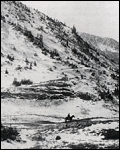 1875 - A mule-drawn railroad reaches Alta for the first time.
1875 - A mule-drawn railroad reaches Alta for the first time.
August, 1878 - Fire destroys much of Alta. The town is never completely rebuilt. The Stilwell store opens. The building foundation is the only remaining structure that still stands from the old mining days. With improvements through the years it will later become the Snowpine Lodge.
February, 1885 - Snowstorm on the 13th and resulting avalanches kill 15 people and destroys much of Alta. Fifty feet of snow is deposited on Main Street.
1896 - Utah becomes a state in January.
1904 - Individual mines become consolidated into three mining companies: Wasatch Mines, Alta United and Michigan-Utah.
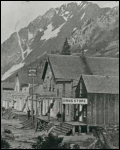 1905-1907 - The Alta Independent newspaper is published.
1905-1907 - The Alta Independent newspaper is published.
1909 - Alf Engen is born in Mjondalen, Norway, son of Trond and Martha Oen Engen.
1916 - Re-discovery of the elusive Emma Silver Vein by Joseph Beeson.
1919 - The Denver and Rio Grande narrow-gauge railroad replaces the old mule-drawn cart.
1920 - Economic depression ceases most mining activity in the area. Little Cottonwood Canyon miner George Watson finds himself one of the sole inhabitants of Alta and promptly elects himself mayor. Watson will acquire old mining deeds over the next years in hope of a mining resurgence in Little Cottonwood Canyon. In the late 1920's Watson's paper fortune begins to evaporate and he looks for ways to lessen his tax burden to the US Government.
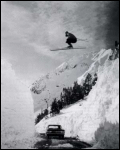 1922 - Elbert Despain begins mail service to Alta. He will continue delivering mail until 1984.
1922 - Elbert Despain begins mail service to Alta. He will continue delivering mail until 1984.
1929 - At age 20 Alf Engen emigrates to the United States first settling in Chicago, Illinois. Engen will eventually relocate to Salt Lake City in 1931. Between the years of 1931-1946 Engen won the US National Jumping Championship title eight times and the National Classic Championship (cross-country and jumping combined) twice. Engen teaches himself how to downhill ski at the age of 30, and wins the National Downhill and Slalom Championships in 1947.
1930 - Alta claims six registered voters.
1935 - World-champion skier Alf Engen is hired by the Forest Service to determine the area's potential as a winter sports site. During the winter Engen skis into Alta from Big Cottonwood Canyon from Catherine's Pass and spends a few days with the Jacobsen brothers who were mining in the area. He visits again during the summer and concludes the area is well suited for development. With Engen's recommendation the CCC begins planting hundreds of trees on Alta's slopes.
1936 - Road to Alta is constructed using the old railroad bed.
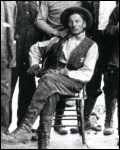 1937 - To ease his tax burden, George Watson deeds 700 acres of surface rights to the US Forest Service for use as a ski area. Wasatch Mines William O'Connor will also deed 900 acres to the project. U.S. Forest Service Ranger C.D. Wadsworth is appointed the first full-time snow and avalanche observer in Little Cottonwood Canyon. His duties include maintaining a weather station and keeping daily weather records.
1937 - To ease his tax burden, George Watson deeds 700 acres of surface rights to the US Forest Service for use as a ski area. Wasatch Mines William O'Connor will also deed 900 acres to the project. U.S. Forest Service Ranger C.D. Wadsworth is appointed the first full-time snow and avalanche observer in Little Cottonwood Canyon. His duties include maintaining a weather station and keeping daily weather records.
1938 - Alta becomes a ski area because of combined efforts of the Salt Lake Winter Sports Association, later known as the Alta Ski Lifts Company, The US Forest Service, Utah State Road Commission, Salt Lake County and The Salt Lake Chamber of Commerce. The Salt Lake Winter Sports Association, a group of local businessmen, raises $10,000 for the construction of the Collins Chairlift.
1939 - First Watson's Shelter is built. The Alta Lodge opens and the Collins Chair operates for the first time on January 15th. Prices are 25 cents for a single ride and $1.50 for a day pass. In February the first use of explosives in avalanche control is credited to Wadsworth and then ski school director Karl Fahrner on Superior Gulch on Mt. Superior. The resulting slide buried 2000 feet of road under 14 feet of snow.
1940 - Alf Engen's brother, Sverre, is hired as a snow ranger for Little Cottonwood Canyon. Assisted by his wife Lois, Engen followed Wadsworth's lead, but also started small slides by ski cutting slopes and also digging snowpits to study different snow layers.
1941 - Company B, 503 Parachute Battalion trains at Alta for the War in Europe. First Alta Ski Patrol is formed. Early members are Jim Shane, Harold Goodro, Dave Shelton, Tom Foley and Gordon Allcott.
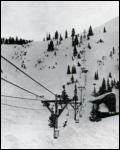 1946 - Monty Atwater succeeds Sverre Engen as snow ranger with the main duty of protecting the skiing public.
1946 - Monty Atwater succeeds Sverre Engen as snow ranger with the main duty of protecting the skiing public.
1947 - Rustler Lodge opens on Thanksgiving Day.
1948 - The Peruvian Lodge opens. Monty Atwater begins using handcharges for avalanche control work.
1949 - The U.S. Forest Service develops an Avalanche Center at Alta. The area was chosen because “this was the first true alpine ski area to be developed in the United States and because detailed records of snowslides have been kept in this area for the past 75 years.” The center at Alta became the regional headquarters and processing base for Steven's Pass, Washington and Berthoud Pass, Colorado.
1952 - Mayor George Watson dies at Alta. Monty Atwater receives permission to fire a World War One French 75mm Howitzer for avalanche control work. Atwater is joined by snow ranger Edward LaChapelle who studied at the Avalanche Institute in Davos, Switzerland. LaChapelle studied snowpits and set up a European-style snow study plot. He also used Cola, a German shepherd, as the first dog used in locating avalanche victims in the U.S.
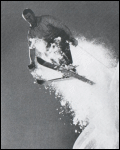 1954 - Germania Chair is constructed and becomes Alta's first double chair.
1954 - Germania Chair is constructed and becomes Alta's first double chair.
1959 - Wildcat double chair is built.
1960 - Original Our Lady of the Snows is built just east of the present-day Photohaus.
1962 - Jim and Elfriede Shane open the Goldminer's Daughter. New chairlift in Albion Basin is built.
1963 - Alta hosts the first alpine Gelande ski jumping meet . It is won by Alf Engen's son Alan.
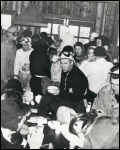 1965 - Alta bypass road is completed on land donated by the Engen's.
1965 - Alta bypass road is completed on land donated by the Engen's.
1967 - Sugarloaf chair is built. The last mine of any appreciable size ends operations in Alta.
1968 - Post office re-opens in Alta. The Chamber of Commerce is established by local business owners.
1969 - Snow Ranger Bengts Sandahl installs the first remote weather station on top of Cardiff Peak. Largely financed with his own money, most of the equipment was carried to the site by Sandahl and Ski Patrolman Hamilton Strayer.
1970 - Alta is incorporated as a town. Lee Bronson is appointed president.
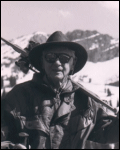 1971 - Sewer line is constructed in Little Cottonwood Canyon.
1971 - Sewer line is constructed in Little Cottonwood Canyon.
1972 - Bill Levitt becomes the elected Mayor. Alta Central is established. The US Forest Service moves the Alta Avalanche Study Center to Fort Collins, Colorado. Ironically, in December a huge avalanche struck the Alta Lodge filling the top floors with snow and depositing a Volkswagen Beetle on the roof.
1973 - Alta's first library is started in the Snowpine Lodge.
1975 - Alta Justice Court begins with Judge Steve H. Stewart and Prosecutor Robert Maack for the first time since the 1870's.
1976 - Alta Volunteer Fire Department is started.
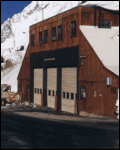 1978 - Alta Fire Station is built.
1978 - Alta Fire Station is built.
1981 - Cecret and Supreme chairlifts are built.
1983 - Albion Ticket Office is built. Alta receives 765 inches of snow during the 1983-84 season.
1986 - Albion Day Lodge is constructed.
1991 - Germania Chair is upgraded from a double to a triple.
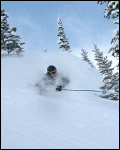 1992 - Sugarloaf Chair becomes a triple. A Yan Kuczynski-designed cross-transfer tow is installed at the base area between Wildcat and Albion.
1992 - Sugarloaf Chair becomes a triple. A Yan Kuczynski-designed cross-transfer tow is installed at the base area between Wildcat and Albion.
1994 - A new two-story office building is constructed. The Alpenglow Restaurant is rebuilt and renamed Alf's.
1995 - Alta Community Enrichment (ACE) is started by area residents.
1997 - Former Alta Ski Lifts General Manager Chic Morton dies on the 14th of July. Alf Engen dies on the 20th of July.
2001 - Alta begins grooming the Nordic Track around the base area and in Albion Basin for cross-country skiers.
2002 - Link between Alta and Snowbird is established in Mineral Basin.
2005 - The new Watson's Shelter is completed. The Germania and Collins chairs are replaced by the new Collins high speed quad.